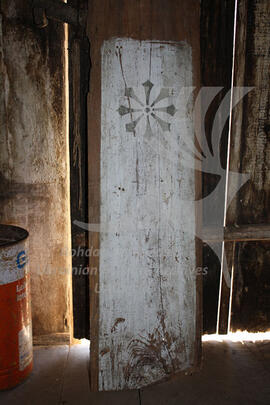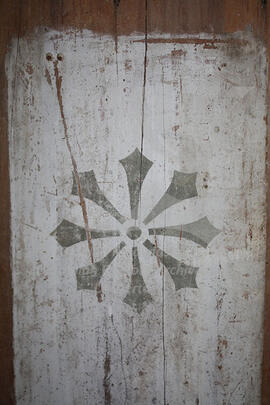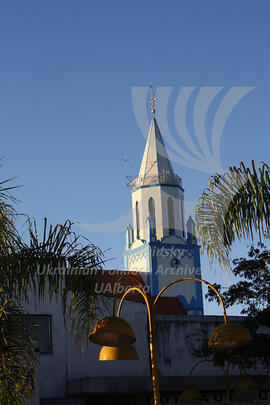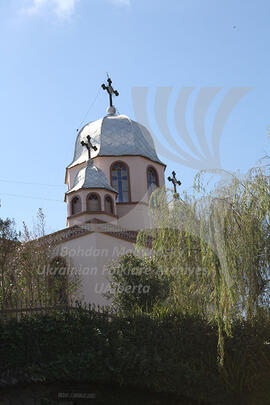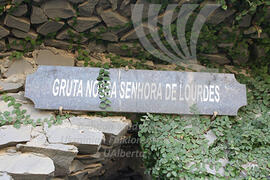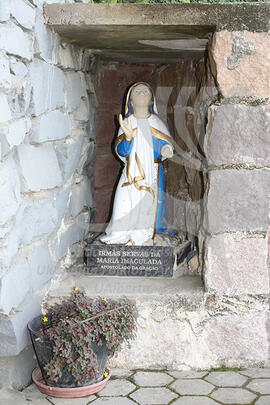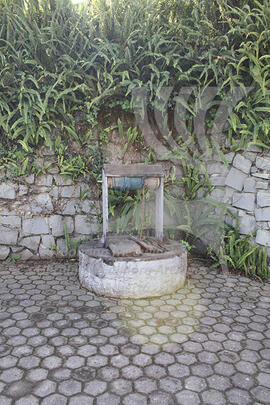Inside the wooden church. A woman is standing with the candle and reading from the book. Three women are sitting by the wall. The women are wearing traditional khustky with kytytsi.
The collection consists of essays and supporting material collected by Frank Fingarsen while taking Ukrainian Folklore courses at the University of Alberta.
Fingarsen, FrankCollection consists of photographs depicting Byzantine rite churches in rural Alberta.
Semchishen, OrestThis item contains two interviews with unknown females. The first interviewee was born in Russia in 1909. She talks about the place where she lived and family members that were starving and being deported to Siberia. She then talks about coming to Canada and what she and her husband did in Canada. She talks about the church and being Lutheran and Evangelic.
The second interviewee's parents came from Poland and she was raised in a Lutheran family. Her family left to Ukraine and then came to Canada in 1927 and moved to Alberta in 1928.
The tape also contains music recordings
This item contains an interview with Mrs. Gauss, who was born in 1898, her maiden name was Zeider (Cyder?). Her mother originally
came from Württemberg. Her family was working on the land, were not rich. There were the only Germans in their village besides one shepherd. There was also a Lutheran church and a German school (education lasted 7 years). Children started going to school when they became seven years old. At the age of fifteen there usually was a confirmation and then they were working for their father until they got married and created own family. Her village was in the Melitopol district and there was a school in Eichenfeld. In general there were 32 family entities in the village each of them were farming and producing goods. Collectivization started in 1917-1918. The relationship with Russian people was good. There usually were many seasonal Russian workers in the German village. German children learned German and Russian languages in the school. Most of the Russian language they learned from Russian workers. Not many girls extended their school education as mothers needed them at home for help. There were eight children in her family, some families had ten, some six. Russians usually were very poor, had many children and not much land. Pomeschiki had more land. Mrs Gauss remembers how people once all together bought land from pomeschik and created a village. Germans were forced to go to the Russian army as well. Tsar Nicolai was loved by Germans. There was a school which educated doctors as well. She was 16 years old when the war started, Germans were forced to join the Russian army, many were captured in Germany and afterwards returned back to Russia. Her village didn´t have problems during the war, they had a cooperative and the living was good. She visited Krym once many years later. Memories on her village during the revolution. People came from Moscow, took what they wanted and went further to other villages.
This item contains an interview conducted with Mr. and Mrs. Sommer. Mrs. and Mr. Sommer are talking about the farm life and their lack of money until the end of the 1930s. They bought their farm taking out a loan with the help of his brother and it paid back step by step. It was a difficult time for them. Their children learned English quickly at school, but Mrs. Sommer mentions that she did
not have any lessons, and could only learn English by herself which took some time. Children went to a German school. Later the children and grandchildren were able to speak English better than German. Mr. and Mrs. Sommer say that they did not had any problems during their journey to Canada because of being Germans.
Mr. and Mrs. Sommer talk about going to church (Lutheran Church, later Protestant). Sermon was preached by a teacher because the German pastor came only once in six weeks.
They came to Edmonton in 1957. Mrs Sommer compares life in Russia with their life in Canada and says that they needed about five years to feel at home in Canada. Later they learned to enjoy their freedom and didn’t want to get back again. They became
Canadian after a few years living in Canada.
Mrs. Sommer talks about speaking German and learning English language. German remained her main language. Mrs. Sommer says that she still cooks the way she learned it in Russia (sauerkraut and borscht).
Mr. Sommer has one sister living in Germany and they have many grandchildren living in Canada.
The collection consists of materials related to the "Church in Ruins" project initiated and conducted by Oleh Iwanusiw. In particular the collection comprises six albums of original photographs predominantly of churches, crosses and Christian sacral places, but also important cultural events and people, scholarly papers and other textual materials related the creator's scholarly interests.
Iwanusiw, Oleh and BozhenaThe collection contains materials of an artist Parasia Iwanec such as photographs and reproductions of her paintings, reviews, newspaper articles about the artist, exhibit programs, biography, personal documents, as well as embroidered shirts and tablecloths, ceramics. A small part of the collection consists of Wasyl Iwanec papers such as official documents, memoirs, and autobiography.
Iwanec, Parasia and WasylThis fragment was brought to the storage after the demolishing of old church. It contains a traditional ornament
Ornament form the fragment of the old church placed in the former kitchen (now storage) on Lozovei's farm
Rome-catholic church in Itaiopolis
Ascension of Our Lady Church in Craveiro
Our Lady Sculpture as an element of Craveiro "Gruta Nosa Senhora de Lordes"
Ascension of Our Lady Church in Craveiro and "Gruta Nosa Senhora de Lordes"
Craveiro "Gruta Nosa Senhora de Lordes"
Sculpture of the Apostle Orasao as an element of the Craveiro "Gruta Nosa Senhora de Lordes"
The interior of Craveiro "Gruta Nosa Senhora de Lordes" with different ritual objects: cross, crucifixion, holy table, sculptures of Jesus Christ, Our Lady, artificial flowers
The well for ritual purposes as a part of Ascension of Our Lady Church Complex in Craveiro
Domes of the Ascension of Our Lady Church in Craveiro
Zapovidi (commandments) on the wall as a part of church interior
